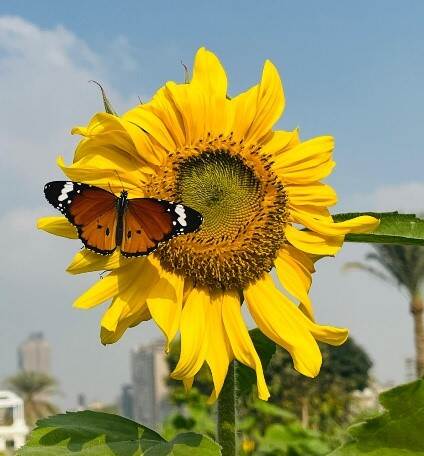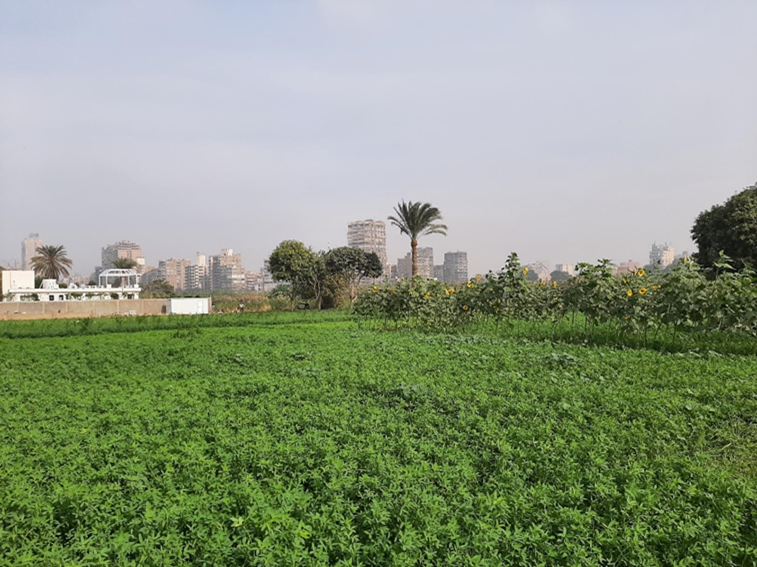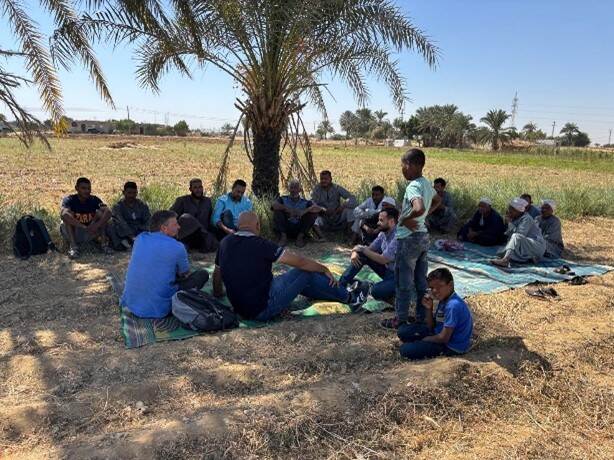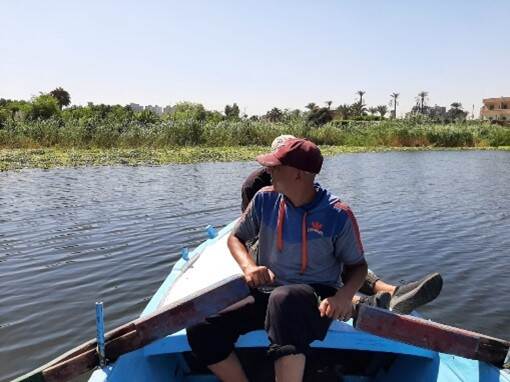Biodiversity in Egypt and Jordan: Insights from three exploratory projects conducted with local partners and Dutch experts
In an era of increasing environmental concerns, three innovative projects supported by the Netherlands Agricultural Network (LAN) in Egypt and Jordan have established initial learnings in the field of biodiversity and climate change adaptation. Introducing the topic to local actors and emphasizing the importance of judicious agricultural practices, grounded in farmers' strong awareness and solid knowledge. These initiatives, from the centre of Cairo, the Beni Suef and Minya regions along the Nile River, and the Jordan Valley showcase innovative approaches to preserving native species and enhancing ecosystem services in agricultural systems and urban landscapes through agricultural biodiversity.

The vegetable production along the River Nile and in the Jordan Valley that represents essential nexuses of agriculture and nature, face profound challenges due to escalating water scarcity exacerbated by climate change, and uncontrolled extractive agriculture. For centuries, these irrigated agricultural systems have relied on the flooding of the Nile and the rain-fed catchment areas that sustain the Jordan River. Recent studies by Wageningen University & Research (WUR), in partnership with regional partners, have high-lighted novel strategies aimed at enhancing biodiversity while intensifying the output from irrigated farming in Egypt and Jordan.
The need for preserving biodiversity in water-scarce regions
The Egyptian and Jordanian agro-ecological landscapes are struggling with multifaceted issues, including acute water scarcity, soil salinity, progressive soil degradation, and diminishing biodiversity as well as agricultural productivity. The shift into monoculture-based systems has compromised ecosystem robustness, thereby heightening vulnerability to biotic and abiotic environmental pressures. Additionally, land use consolidation efforts are threatening diverse habitats, further accelerating the decline of native species.
The Netherlands Agricultural Network (LAN) team at the Dutch Embassies in Cairo and Amman, has explored partnerships and innovative avenues to address these challenges. The approach focuses on empowering local communities, supporting biodiversity, restoring ecosystems, and improving water management. The Netherlands is exploring measures to prevent the detrimental losses of biodiversity caused by agricultural activities including land use consolidation. This is done by promoting Nature Inclusive Agriculture (NIA) with the support of Wageningen University & Research. The three underlying and interconnected dimensions of NIA are (i) to employ ecosystem services and functional agrobiodiversity rather than external inputs; (ii) minimize environmental pressures and (iii) contribute maximally to nature conservation and landscape quality”.
Functional Agrobiodiversity (FAB) as a viable strategy
The impact of the loss of flora and fauna in the agricultural landscape on agricultural production is increasing. The main reasons for this are the decline in abundance and diversity of soil living organisms, decline in natural predators or parasitoids of pests, and decline in pollinating insects due to habitat destruction and indiscriminate pesticide and fertiliser use, combined with large-scale monoculture. Today, in the Netherlands, natural plant biodiversity and crop diversity are widely recognized as essential for the benefit of agriculture, supported by various ecosystem services collectively known as Functional Agrobiodiversity (FAB):
Functional Agrobiodiversity (FAB) emerges as a compelling paradigm to mitigate decline in agricultural productivity and natural biodiversity. FAB underscores the integration of biodiversity to supply critical ecosystem services, incorporating pest regulation, pollination, and the enhancement of soil health.
Through capacity building of farmers in good agricultural practices, including judicious use of agrochemicals and the strategic inclusion of diverse flora and the meticulous management of field margins, farmers can substantially reduce their dependency on agrochemicals while supporting biodiversity and fostering ecological balance. Land use consolidation, aimed at streamlining farming operations and facilitating the efficient implementation of advanced technologies, needs careful planning. It is essential to integrate nature-inclusive tools to ensure that land use consolidation efforts are designed with biodiversity in mind.

Insights from recent studies in Egypt and Jordan
- Capacity building of farmers on Nature Inclusive Agriculture (NIA) – and good agricultural practices: training of farmers and farm advisors on good agricultural practices, integrated crop management and NIA practices (including appropriate land preparation, irrigation technologies, judicious use of agrochemicals etc.) can potentially foster far reaching impacts on biodiversity conservation, agricultural output and farmer income. Where possible NIA encourages alternative earning models for farming communities and primary producers, for example, eco-tourism, and other eco-system services beyond the sole provision of food and material.
- NIA can add opportunities for alternative earning models for farming communities. Primary producers can offer other eco-system services beyond the sole provision of food and material, such as native plant conservation, carbon sequestration, and soil biodiversity and water conservation.
- Where possible, NIA encourages alternative earning models that enhance both economic resilience and biodiversity. Agro-eco-tourism, in particular, offers opportunities by attracting paying visitors interested in sustainable farming, native plant landscapes, and agri-educational experiences. The Very Nile initiative on Al-Qursaya Island in central Cairo is implementing such an approach by helping the local community generate additional income through guided tours, native plant conservation, boat tours, and the promotion of biodiversity-friendly agriculture, which in turn supports a restaurant serving local seasonal produce.
- Soil health and water management: The incorporation of service plants in agricultural systems has demonstrated substantial enhancements in soil structure and water retention. Combined with selected flowering and nitrogen fixing species, these botanical interventions not only supply vital resources for pollinators and natural pest predators but also serve as natural plant nutrition, having strong regenerative functions on soil health.
- Biodiversity and pest regulation: Extrapolation of empirical evidence from Dutch field studies underscores the efficacy of diverse habitats and service crops, such as floral field margins and field borders with grasses, shrubs and trees, in amplifying populations of natural pest antagonists through conservation biological control.
- Collaborative engagement and knowledge exchange: A key component of the initiative is the synergetic collaboration between local practitioners supported by Dutch experts. Through a series of workshops and in-situ evaluations, a robust exchange of insights on biodiversity conservation in water scarce landscapes has been facilitated. A recent regional seminar organised by the Jordan HortiFuture (JHF) project, involving among others the Royal Botanical Garden (RBG) and National Agricultural Research Centre (NARC) in Jordan, as well as explorative visits to the LAND-at-scale network in Egypt by researchers from Wageningen University & Research, exemplified this collaborative spirit, focusing on prospective R&D projects in Functional Agrobiodiversity (FAB).

Strategic recommendations
To actualise the potential of Functional Agrobiodiversity (FAB) practices, the following strategic priorities are recommended:
Capacity enhancement: Implement training programs and provide material resources to equip local communities with the skills needed to adopt biodiversity-enhancing practices, enabling farmers to become more productive, reducing costs and increasing income.
Diversification of agroecosystems: Promote or maintain polyculture and the establishment of semi-natural habitats to enhance multifunctional ecosystem services. Crop diversity is more productive!
Rigorous monitoring and evaluation: Deploy comprehensive monitoring systems to quantify the impacts of current and future FAB interventions on pest dynamics and agronomic performance.
Policy formulation and advocacy: Champion information for policy makers that incentivize the integration of sustainable agricultural practices and biodiversity conservation, ensuring enduring ecological and economic benefits.
The adoption of Functional Agrobiodiversity in the agricultural systems along the River Nile and the Jordan Valley represents a paradigm shift towards a resilient agro-ecological framework. By fostering collaborative synergies and leveraging innovative approaches with ancestral knowledge, these initiatives enhance agricultural sustainability and contribute to the broader goal of regional ecological stewardship. Supported by efforts from the Netherlands, this includes the restoration of wetlands with native plant species, which are crucial for water filtration, flood control, and providing habitats for diverse species.

Training farmers and supporting biodiversity
Effective learning about Nature Inclusive farming practices is best achieved through local community champions who support and advise smallholder farmers. This approach is grounded in the principles of “seeing is believing” and “learning by doing”. Engaging agricultural professionals in training programs and exposing them to new innovations, with field visits and practical in-field training as key components. These hands-on experiences facilitate real learning in agriculture, enabling growers to apply new knowledge and practices directly on their farms.
The key to effectively supporting biodiversity lies in landscapes where sustainable land use is actively practiced by farmers among others. By integrating conservation with everyday farming activities, these dynamic landscapes can foster biodiversity while simultaneously enhancing the livelihoods of those who rely on the land, creating a mutually beneficial relationship.